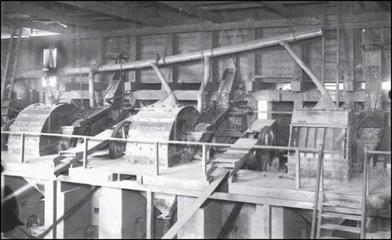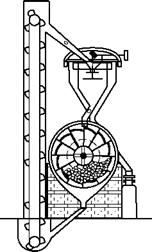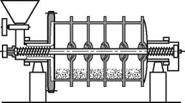Although ball mills were tested in the 1860s (Del Mar 1917), the main progress in fine grinding during 1870-1900 was in Germany. The German mineral industry had started to decline after hundreds of years of world leadership, but the cement industry was growing and with it the demand for fine grinding of clinker. The growth of chemical engineering in Germany during that time also created a demand for very fine particles for use in chemicals, paints, pharmaceuticals, and other products. Invention was the order of the day, so it is not surprising that
…in 1876 a machine was proposed by Gebruder Sachsenberg in which the screening device fixed on wooden frames surrounded the grinding drum and rotated with it. The material passing through the screen formed the finished product and was caught in a casing surrounding the machine, while the material retained on the screen was returned to the inside of the mill through special openings. (Scheibe 1993)
The mill was designed by the Sachsenberg brothers in Roblau-on-Elbe and W. Bruckner in Ohrdruf and in 1885, a mill was built in H. Gruson’s workshop in Magdeburg, Germany (Naske 1911). It was the first tumbling mill to gain reasonable acceptance in the industry. The Krupp Company, which was dominant in Germany at that time in manufacturing heavy steel equipment, acquired Gruson’s company and built the Krupp-Grusonwerk mill. Figure 7.1 shows the Sachsenberg mill.
The mill consisted of a drum lined with steel plates with the leading edge of one liner sitting on the trailing edge of the next. The grinding media were steel balls 63-100 mm in diameter, and the steps in the plates kept them in motion and grinding clinker when the mill was rotating. Fine particles were discharged from the mill through apertures in the plates, and coarse particles in the discharge were screened and reentered the mill through slits between the plates.
The early Krupp-Grusonwerk mills were dry mills. Because cement production in 1885 was still small, progress with tumbling mills was slow. But rapid growth of the cement industry brought them to the fore, and by the end of the 19th century tumbling mills were being used to grind metalliferous ores to prepare them for the cyanide process. A few years later ball mills were being used to grind ores for flotation. Figure 7.2 is a photograph of three Krupp-Grusonwerk mills that were used for dry grinding gold ore in Kalgoorlie, Australia, in 1905. A problem with the Krupp-Grusonwerk mill was that the apertures in the drums through which the ground particles were discharged had to be large enough to minimize blocking, and this gave a rather coarse product, which
|
|
|
FIGURE 7.1 Sachsenberg mill, the first model of the Krupp-Grusonwerk mill (Tiggesbaumker 2001; reprinted by permission from Krupp Polysius, a Company of ThyssenKrupp Technologies)
|
made substandard cement. In a later form of the mill, the product was discharged through an end trunnion, which improved the performance considerably. By 1900, a mill 1.2 m in diameter and 6 m long and using flint pebbles ground 3 tph of shaft kiln clinker to cement (Scheibe 1993).
The solution to the problem of large particles in the product was to operate the mill in closed circuit with an air classifier, collecting the fine particles from the classifier in one product and recycling back to the mill the large particles that were in the other product. The Askham air separator was patented by Mumford and Moodie in 1885. Figure 7.3 shows how an Askham separator was used in closed circuit with a Krupp-Grusonwerk
|
|
|
FIGURE 7.3 Krupp-Grusonwerk mill in closed circuit with an Askham air separator (West 1910)
|
|
|
FIGURE 7.4 Ideas for continuous ball mills in the late 19th century (Scheibe 1993; reprinted by permission of Klaus Graichen) mill. This type of circuit started a trend that eventually changed industrial grinding processes from mainly open circuit to mainly closed circuit. But it would not become common practice for many years. By 1900, tumbling mills were competing successfully for grinding cement clinker with Griffin-type centrifugal pendulum mills.
The inventors of the day had many ideas about ball mills, and Figure 7.4 shows some methods that were considered for continuous ball mills. Ultimately, the simplest idea proved to be the best: grind in a cylinder with ore entering one end and leaving the other.





